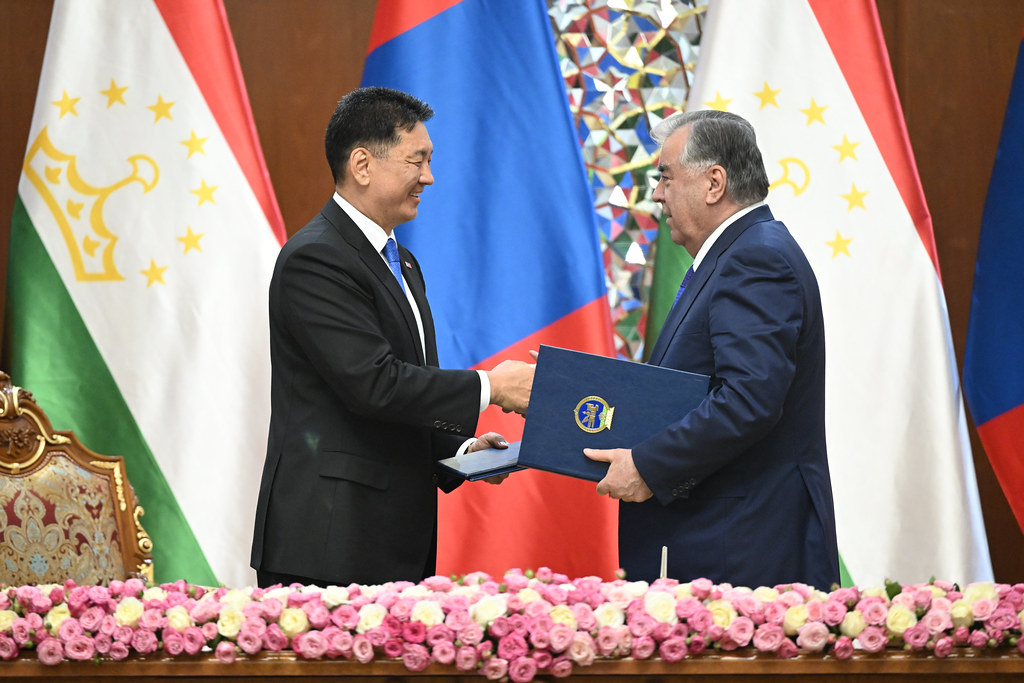DUSHANBE, Tajikistan, July 26. Diplomatic relations between Tajikistan and Mongolia, established on April 24, 1992, had developed at a moderate pace over the past three decades. However, a notable revival of bilateral dialogue is now underway. A significant milestone was the first-ever state visit of the President of Mongolia to Tajikistan, which took place from July 24 to 26, 2025. Talks between Mongolian President Ukhnaagiin Khürelsükh and Tajik President Emomali Rahmon in Dushanbe demonstrated the determination of both sides to deepen and expand their partnership.
Against the backdrop of a still modest trade turnover, there is evident political will to enhance cooperation in areas with substantial, yet untapped, economic potential. While mutual trade amounted to only $50,000 in 2024, it reached $203,400 in the first half of 2025 - an increase of more than 14 times year-on-year. Despite the small absolute numbers, such growth reflects mutual interest in strengthening economic ties.
Currently, trade remains largely one-sided: Tajikistan imports wool, cashmere, leather, meat, and related products from Mongolia, while its exports, primarily fruits, vegetables, cotton, and textiles, remain limited.
A key event of the visit was the first Tajik-Mongolian business forum, which brought together around 150 business representatives. The forum resulted in the decision to establish a Business Council to serve as a bridge between entrepreneurs of both countries, facilitating new formats of cooperation and investment.
It is evident that transitioning from political declarations to real economic engagement requires systematic preparation. With this in mind, President Emomali Rahmon proposed the development of a joint roadmap for enhancing trade and economic cooperation. This document should include specific projects and mechanisms for supporting the private sector, ensuring a move toward practical cooperation within a clear and long-term strategy.
Agriculture was identified as one of the priority areas for cooperation, particularly in livestock farming. Mongolia expressed its readiness to supply high-quality halal meat products to Tajikistan and proposed collaboration on veterinary and sanitary control. Tajikistan, in turn, proposed increasing imports of Mongolian wool, leather, and cashmere products, as well as expanding the export of fruits, vegetables, and canned goods. Joint projects for processing wool, cotton, and cashmere are under discussion, aligning with Tajikistan’s textile industry development program and Mongolia’s White Gold initiative.
A Memorandum of Understanding signed during the visit covers a wide range of agricultural areas - from crop and livestock production to mechanization, seed production, pest and disease control, land reclamation, and professional training and exchange of specialists.
In the energy sector, discussions focused on the green agenda and sustainable development goals. The two countries plan to deepen their exchange of experience in designing and building hydropower plants, as well as in human resource development. The corresponding MoU includes cooperation in hydropower, expert exchange, training programs, and implementation of joint initiatives.
Mongolia has expressed special interest in Tajikistan’s experience, as the country meets more than 98 percent of its electricity needs through hydropower. As the Mongolian president noted: “We highly value Tajikistan’s policy and experience in strengthening its position in renewable energy and attach great importance to further cooperation. This partnership can serve as a model for green development and the rational use of resources by landlocked countries.”
Logistics challenges were also addressed. During the talks, the sides agreed to jointly tackle transport barriers, develop new routes, and integrate into regional infrastructure networks.
“There is a shared understanding of the need to develop the shortest road routes between our countries, establish direct air links, and create new transport corridors, which will contribute to regional trade and economic integration,” said the President of Mongolia. Overcoming geographic limitations through joint infrastructure projects is seen as key to boosting mutual trade.
Other promising areas of cooperation include mining, mineral processing, and the development of light and food industries based on local raw materials. Tajikistan proposed exploring the creation of joint ventures in these sectors.
The sides reaffirmed their commitment to strengthening cooperation within international organizations such as the UN and the SCO and expressed solidarity in addressing global challenges, including climate change.
More talks were held on working together on natural disaster management, including risk reduction, early warning systems, using modern tech, and joint emergency response drills.
In conclusion, Tajikistan and Mongolia are undergoing a qualitative transformation in their relations. Despite a modest history of interaction, both countries are demonstrating a focused intention to expand political and economic cooperation. They share a clear understanding of the importance of implementing concrete projects, building sustainable institutional mechanisms, and aligning national strategies. Together, these efforts form a solid foundation for comprehensive and long-term bilateral relations.







